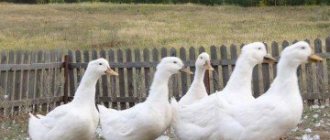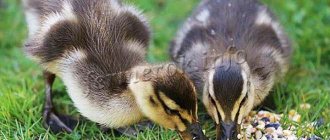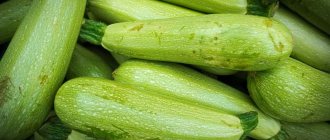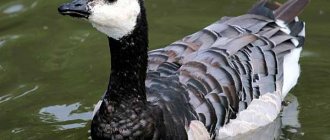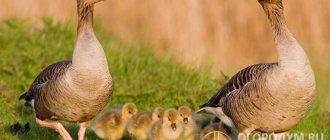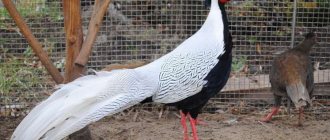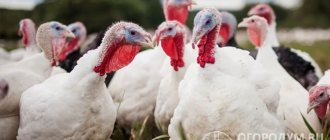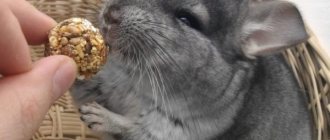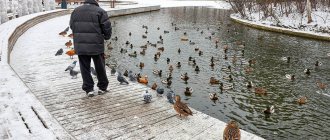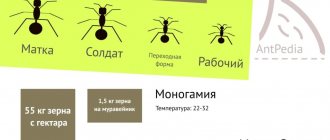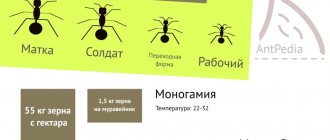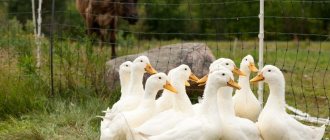Under natural conditions, the menu of a wild duck differs significantly from the usual diet of poultry. Few people think about this when feeding the ducks in the park with bread or seeds. In order not to harm birds, you need to know what the correct diet of wild birds is and what delicacy will be safe for waterfowl living in a park or on a lake.
Is it possible to feed wild ducks in parks and ponds?
Feeding wild ducks
Ornithologists strongly discourage feeding ducks in the wild. Nature has it in such a way that birds obtain food on their own. But the usual human factor pushes many people to immediately feed a bird that comes into view. This leads to the fact that the birds get used to regular, albeit not entirely healthy, food. And they stop producing it on their own.
The disastrous consequence is that with the onset of winter, it does not fly to warmer climes and remains in its feeding place. It is in winter that feeding wild ducks remaining in place becomes especially important.
Contrary to the established stereotype, fresh bread and baked goods are contraindicated for birds. Due to the yeast content, they promote the development of fermentation processes in the intestines. In addition, the duck strives to fill its stomach with them, and as a result, it ignores other food that is more beneficial for it. In addition, all kinds of food not eaten by birds, which people throw into water bodies, causes their pollution. The optimal food for ducks living in a park or pond is:
Feed for ducks
- a mixture of cottage cheese, grain and finely chopped herbs;
- oatmeal;
- fresh soft berries and fruits;
- boiled vegetables;
- grated cheese;
- ready-made feed intended for feeding ducks.
Each of the proposed options should be crushed or finely chopped. It is better to feed ducks by leaving food on the ground near the water. After all, they may not eat everything, and the food remaining in the water will begin to rot.
Feeding wild ducks in the park
Along with fresh white bread, ducks should not be fed black bread. It causes fermentation processes that have a severe impact on the digestive system. In addition, prohibited foods include excessively fatty and dairy products, peanuts, and fried seeds. Missing food with mold on it can cause the development of the fungal disease aspergillosis. Also, you should not offer porridge after heat treatment. They quickly disappear and cause inevitable frustration.
By nature, wild ducks are absolutely omnivorous. Getting used to regular abundant feeding from humans, they stop caring about obtaining food on their own. This entails irreversible disorders of the digestive system and often death in winter, with the onset of cold weather.
Diet depending on the time of year
Based on climate change throughout the year, the poultry farmer has to adjust the pet menu so that it remains complete.
Winter
Ducks spend most of this time of year indoors. They are fed grain feed with the addition of protein products (meat, fish, cottage cheese, fish and meat and bone meal). Greens are replaced with fresh vegetables and herbal flour, sprouted grains.
Complex vitamins must be added to food or water.
Spring
The spring diet does not differ from the winter one until the birds are released for walking. By eating fresh grass and being in the sun, ducks no longer need vegetables and synthetic vitamins.
Summer
In summer, ducks spend most of the day on the pond or on the run. Their diet is as close to natural as possible - the birds feed on aquatic and coastal vegetation, and they themselves forage for insects and mollusks in the water.
The poultry farmer needs to enrich the summer diet with grain feed in the amount of 50–80 g per head.
Autumn
In autumn, the bird needs to gain fat before flying to warmer climes or wintering in place. Domestic ducks don't fly anywhere, but instinct forces them to show an insatiable appetite at this time of year. The birds' diet is dominated by cereals. Ducks are fed grain mash with the addition of cake.
Feeding wild ducks in the natural environment or at home requires compliance with a number of rules aimed at maintaining the health of the bird. Birds living in a park or near a nearby body of water can be fed with grain, fresh vegetables or special grass pellets. Roasted seeds, snacks or bread should not be given.
Which foods are good for ducks and which are harmful?
Along with products that are beneficial for poultry, there are many that are harmful. Accordingly, the first should be present in the feed, but the second should be absent. Many novice farmers do not have knowledge about the benefits and dangers of products. Therefore, the livestock often gets sick, does not lay eggs well, and does not grow meat well. To avoid this, you need to give the birds purely healthy food.
Grain is an essential ingredient in duck feed.
Products useful for ducks:
- Most cereals. Wheat rich in proteins and vitamins, nourishing barley, and oats that promote growth and health are suitable for feeding birds. Barley is not suitable for ducklings due to its hard shell, but it is beneficial for adult birds.
- Corn. This is a cereal, but it stands apart because of its enormous benefits for the growing duck body. Its amount in the diet of adults can be reduced, but chicks need a lot of corn. It’s good if it makes up 50% of the total weight of the daily diet.
- Greenery. Beet tops, finely chopped green grass, nettle (need to be doused with boiling water), duckweed - these have nutritional properties and have a positive effect on poultry.
- Legumes. They contain proteins that are extremely beneficial to birds. Peas are usually used - they are the most accessible. Other types of legumes are also suitable.
- Fish, meat and bone meal, incubation waste. These supplements contain proteins, phosphorus, calcium, and beneficial microelements.
- Dairy products. Cottage cheese is considered the main dairy product for feeding ducks. He's very helpful. To prepare a wet mash, you can use whey or milk instead of water. With large birds this is expensive, but for small ducklings it works just fine.
- Vegetables. The duck body reacts especially well to pureed cabbage and carrots. However, you should be careful with melon crops.
- Cake, meal, bran. In moderate proportions (up to 10%), these types of foods are very healthy. They contain potassium, the necessary amount of protein and fat.
- Shells, chalk, coarse sand, eggshells. These sources of calcium are present in small quantities in any good diet.
- Mineral supplements, table salt. In small quantities, these supplements are very useful. It is recommended to dissolve salt in water so that it does not burn the esophagus and intestines. It should not be more than 0.2% of the food volume.
Next, let’s look at harmful types of food that are recommended to be excluded from the birds’ diet:
- Bread, bakery products, baked goods. We will tell you more about them towards the end of the article. It is only worth noting that these types of food are harmful to most birds - not just domestic ones. Stomach blockage and yeast fermentation in the intestines are not the most favorable outcome for birds.
- Crackers. For some reason, many people believe that if the bread is dried, it won’t do any harm. This is wrong. Even a crusty cracker can swell in the stomach if left there for long enough. The chance is significantly lower than with fresh bread, but is there any point in taking the risk?
- Flour. While fish and meat and bone meal are very beneficial, regular cereal meal is not recommended. It clogs the airways of birds.
- Ready-made porridges (especially with milk). These are perishable types of food that cause digestive upset.
- Pumpkin, zucchini. Ducks react neutrally to most vegetables, but melons and melons harm them a little. The main reason for this phenomenon is the laxative effect. Pumpkin and zucchini help remove calcium from the bird's body. As a result, she may have trouble standing on her feet.
- Any products with mold. Mold causes a dangerous disease - aspergillosis, so you need to remove any types of food from feeders if mold appears on them. Even if it's healthy food.
- Maple leaves, poisonous herbs. What is harmful to humans is also harmful to birds.
How to help ducks in winter?
In zoos, waterfowl are fed specially prepared food in winter. They include all the nutritional elements (protein, carbohydrates, fats) that ducks can get from their usual food. But compassionate townspeople continue to feed the ducks remaining for the winter with baked goods and leftover bread.
Without receiving the necessary nutrients, the bird weakens and becomes more vulnerable to cold and disease. Trying to help starving waterfowl, people often cause irreparable harm to them. What to feed ducks in winter to really help them survive severe frosts?
It is advisable not to feed baked goods to the bird. The ducks will eat, but they won’t be able to get anything but harm from such food. You can prepare high-quality food for ducks of different species overwintering on a pond yourself. Its basis can be whole grain (oats, barley, wheat) or pearl barley, oatmeal, whole grain crushed grain (corn, barley, wheat). Under no circumstances should you feed semolina and rye (rye flour) to the bird in its pure form. These feeds can be included in the grain mixture in an amount of no more than 10% of its volume.
Grain mixture
Protein components of bird feed can be as follows:
- fish or meat waste;
- egg;
- meat, fish, bone meal;
- bone residue in the form of minced meat (sold in grocery stores);
- peas;
- sunflower, soybean, rapeseed cake or meal;
- low-fat cottage cheese.
Meat or fish waste should not contain large bones. They can be fed raw or cooked. Before feeding, the egg should be hard-boiled and chopped together with the shell.
Protein components are mixed with grain feed. Grain for ducks can be pre-boiled or steamed, but in severe frosts it is better to give it dry so that the food does not have time to freeze. Whole grains can be sprouted before feeding until green sprouts 1-2 cm long appear. This food significantly increases the content of vitamins and biologically active substances that are lacking in the winter diet of birds.
Vitamin feed for wild ducks
But what should you feed wild ducks to enrich their diet with the fiber and vitamins they need? For waterfowl wintering in urban reservoirs, the following food can be prepared:
- dried nettle, clover, alfalfa, dandelion;
- any root vegetables;
- pumpkin or zucchini;
- fresh cabbage.
In summer, dry herbs can be cut and dried in small bunches in the shade to retain more beneficial vitamins. Everything else can be grown in your personal garden or purchased specifically for poultry at the grocery store. But it is much more economical to use leftover vegetables that city residents are accustomed to throwing away. Potato peelings, carrot and beet trimmings, unnecessary leaves of white cabbage or Chinese cabbage, lettuce, yellowed dill or parsley, watermelon and melon rinds, zucchini seeds and much more will be readily eaten by ducks.
Ducks can be fed any root vegetables
Some vegetables need to be chopped before feeding. This applies to hard root vegetables and raw potatoes. Since birds do not have teeth, they will not be able to gnaw hard vegetables, and the flat beak of ducks does not allow them to peck carrots or beets. Therefore, all root vegetables with a dense structure must be grated or, raw or boiled, passed through a meat grinder. The same should be done with zucchini, pumpkin, and watermelon rind.
Leafy vegetables such as cabbage can also be given whole. The ducks do a good job of picking them off, tearing off small pieces. Dried herbs or bundles of hay are also not chopped.
As spring approaches, vegetables begin to sprout even in a cold cellar. Ducks will like young carrot or beet leaves. Trimmed tops of root vegetables or green feathers of onions and garlic will be very useful in the vitamin-poor winter diet of birds. If desired, you can specially germinate small root crops by planting them in a box with wet sand, sawdust, soil, and then feed the ducks with fresh herbs.
Useful and harmful products
Adults and children, walking through the park, love to feed the ducks on the pond. They find this activity exciting and useful. They say that man saves his little brothers from starvation. Not everyone knows that there are products that harm the body of birds.
The food must be balanced, with sufficient protein content. It is not necessary to choose proteins of plant origin; animal proteins are also suitable. You should also make sure you have a large amount of vitamins and microelements. Among the latter it is necessary to highlight:
- copper;
- calcium;
- magnesium.
Diet of domestic ducks raised for meat
Fattening of a duck for meat is carried out within two and a half months from the moment of its birth. At first, kids eagerly gobble up boiled eggs and cottage cheese with a minimal amount of fat. You should be careful when choosing products, as the duckling’s stomach is delicate and sensitive.
Before slaughter, about fifteen days, food with a high protein content is introduced into the diet. This could be legumes, cottage cheese, potatoes, and so on. When fattening, fish products are excluded from the diet and the physical activity of the bird is limited.
What types of food are suitable for wild animals?
What to feed wild ducks is useful to know for those who at least sometimes feed them. It is optimal to use food of grain origin or made from legumes. A special compound feed would also be a good option.
It should be remembered that wild ducks should not be given the same type of food. It should be changed periodically, or even better, mixed. Combined food is ideal for birds.
Cereals are excellent food for ducks
Excellent food for wild ducks include:
- barley;
- oats;
- wheat;
- corn;
- peas.
The share of barley in the feed mixture must certainly be 30-35%. The composition and ratio of other components changes at your discretion.
Compound feed
The modern market provides a wide selection of combined feeds. In addition to the main elements, they usually contain a variety of useful additives. The main ones are amino acids and minerals. It is better to choose food that is created specifically for ducks. It is quite possible that it will be possible to obtain a composition intended specifically for wild ducks. True, this is quite rare, but the food exists.
If wild ducks are kept in a household and granular feed is purchased for them, then it should be soaked before feeding it to the birds. This way, not only will it not fly around the enclosure, but it will be easier to eat. But the food has a drawback: a rather high price. If there are not a lot of birds, then the difference is imperceptible, but with a large number of birds the amounts come out to be decent. Self-prepared mixtures are much cheaper at cost.
No need to buy the cheapest combination food
It is important to follow the manufacturer’s instructions, quantitative composition and expiration date. Otherwise, due to improper nutrition, ducks may be susceptible to various diseases.
Dry mix
It is better to create a diet for domestic birds yourself. If a bird is fattened for meat, then after the third week of life it should significantly increase the amount of feed (three times). And when young animals are kept for other purposes, such an increase will be inappropriate.
The diet of adult ducks and ducklings is different
Dry mixtures purchased at a specialty store or farm market contain a balanced complex of vitamins and microelements. The ducklings quickly gain weight, and after a couple of months they are ready for slaughter. It is recommended to moisten the mixture before using it.
How to prepare compound feed yourself? Recipe
Preparing feed for domestic ducks is a great way not only to save money, but also to be confident in the quality of the product. The ingredients you will need are:
- corn flour;
- wheat bran;
- greens (nettle leaves, clover, alfalfa, willow leaves).
It is recommended to prepare such a volume of feed that the birds can consume within 24 hours. This is due to the fact that the shelf life is short and the composition of the product begins to deteriorate quickly.
First of all, you will need a container with a volume of 10 liters. The chopped greens are poured with boiling water and left to cool for 30 minutes. Then 0.5 kilograms of corn flour and 1 kilogram of wheat bran are added to the mass. The resulting mass is thoroughly mixed. The result should be a thick and dense mass.
You can see the preparation of duck food in the video below:
What not to feed wild ducks and chicks
Ducks should not be fed bread. Moreover, in any quantity and in large quantities, especially baked goods and black bread are prohibited. Do not feed ducks at any age fatty foods. Fried seeds, peanuts, and fatty dairy products are prohibited. Cottage cheese is given only to small downy ducklings.
And definitely don’t throw everything you eat into the water. Ducks may pick up a product that is obviously harmful to them. Moreover, food in water quickly deteriorates, as a result, birds eat food contaminated with fungus or putrefactive bacteria.
By feeding ducks, a person believes that he is helping these birds in difficult times. However, this is not always the case. Not only domestic ducks, but also wild ducks need to be fed correctly. Otherwise, your care may cause the death of birds.
Diet for increasing egg production in ducks
Good egg laying in domestic ducks requires adherence to a certain diet. During the egg-laying period, birds need to increase their intake of minerals and calcium. Every day a laying hen should drink about one liter of water. It is not recommended to give excessively wet food.
During this period, the bird should be fed no more than four times a day with any food, but with the addition of a yeast solution. To prepare it, you need to dissolve the yeast in warm water, at the rate of twenty grams per liter of liquid. Mix the resulting solution with the main feed.
Feeding wild ducks in winter
On a note! You cannot constantly feed ducks: the bird quickly gets used to free food and systematic treats. When winter comes, the ducks simply won't want to leave the city. There is no need for them to fly south if food is plentiful.
Caring for ducks
If the ducks have not flown away to their winter quarters but remain on the pond, then they must be fed. For this purpose, feeders are installed for wild ducks, which are systematically replenished. In this case, it is necessary to ensure that the remaining feed does not freeze (remove them in a timely manner).
Duck feeder
The question naturally arises - what to feed wild ducks in winter so that the bird remains healthy and can hatch its offspring in the spring. Well-wishers advise catching the birds and keeping them in poultry houses until spring.
Procurement of feed
Over the summer, you can prepare a lot of healthy food for wintering ducks: cabbage, dandelion, nettles, zucchini, alfalfa, pumpkin, and any root vegetables.
It is better to dry herbs in small bunches. Hang them in the shade to better preserve vitamins. Vegetables can be purchased or grown.
In winter, ducks need more grass meal. They need sprouted grains, and the need to consume sand and gravel increases. In the summer this was not a problem for the ducks, since they found everything they needed in the pond, but in the winter the birds themselves cannot get them.
In winter, ducks need more grass meal
Any duck food is pre-ground. There is no need to throw it into a pond - it will sink to the bottom and part of it will rot. The food is placed in feeders on the shore and the ducks willingly eat it if desired.
Important! Birds need to be fed only in winter, if for some reason they had to stay. Since wild birds are not at all whimsical in their care, the only serious problems are chipping ice when necessary, and feeding
Since wild birds are not at all whimsical in their care, the only serious problems are chipping ice when necessary and feeding.
Cereals for feeding ducks
- Corn is a valuable source of fiber and protein for wild birds. The grains have a rich yellow color, which means they contain a large amount of carotene, which is converted into vitamin A.
- Oats contain fats and amino acids that are so important for ducks.
- Barley is the basis of the feed mixture. Its content should not decrease beyond the level of 30%. Any grain can be used: soaked, crushed, whole, sprouted. The only condition is that only adult birds should consume it (ducklings are strictly prohibited).
- Wheat is rich in vitamins and proteins. Wheat of any kind is added to feed compositions. Sometimes wheat is replaced with millet.
- Peas are introduced to ducks gradually. It must first be crushed. Some individuals do not eat peas and legumes.
Combined feeds are available in a wide variety at agricultural markets. They consist of ready-made mixtures of products, crushed to the required state. In addition to them, the feed is enriched with a number of useful additives, such as amino acids, vitamins, and minerals.
Among the variety of products there is also specialized feed for ducks. You can also find products designed specifically for feeding wild breeds of ducks on private property.
Feed for ducks
Important! Most feeds are in the form of dry granules. Before feeding the food to the ducks, it must be slightly soaked in water.
Wet feed is much easier for ducks to absorb because it does not stick to their beaks. This will also save significant production since duck pellets will not be scattered throughout the area.
Although it is easier to purchase ready-made feed than to prepare it yourself, the cost price is a significant overpayment. If you feed a large number of ducks, it will be very expensive.
As a last resort, you can use standard chicken feed. It also contains all the components and additives necessary for birds.
Mash
In winter, ducks need to be fed moistened mash. Despite their varied composition, the basis is almost always compound feed.
Preparing duck mash
Finely chopped grass, all kinds of grains, cottage cheese, berries, and oatmeal are added to the wet mash. Closer to spring, food for ducks needs to be made more varied, since eggs are laid in birds in March.
It is very important for wild individuals to mix fishmeal into their food during this period.
If wild ducks, who by the will of fate remained for the winter in city ponds, are fed correctly, then this will turn out to be a real and invaluable help for them. Having survived the harsh winter, beautiful and healthy ducks will liven up the park's landscape next summer.
What can you throw into a pond?
During wintering, birds require a good mixed diet, which includes the following cereals:
- millet;
- barley groats;
- peas;
- pearl barley;
- oats;
- wheat.
The combined mixture will help feed ducks.
The benefit of oatmeal lies in the high content of amino acids and vegetable fats. Barley and pearl barley are enriched with protein and fiber. Wheat contains a lot of B vitamins.
Note! Peas should be thrown into the pond for birds only in crushed form.
You can feed with boiled vegetables, observing the obligatory condition - thoroughly grind the product:
- potato;
- carrot;
- beets.
Seashells and eggshells will help birds replenish their mineral supply. No less useful will be a herbal mixture, which includes:
- nettle;
- dandelions;
- clover;
- alfalfa.
On a note. It is allowed to use vegetable waste as feed instead of vegetables.
It is recommended to supplement the diet with products of animal origin:
- meat flour;
- boiled eggs;
- fish.
Boiled eggs can be chopped directly with the shell. Meat components, which can also be fed to wild ducks, are best mixed with the grain mixture. If the air temperature outside is sub-zero, you should give raw cereal instead of boiled cereal. It should be remembered that too much food can lead to obesity or even death of birds.
Is bread harmful to wild ducks?
For the birds that inhabit park ponds, bread is the fastest and most affordable food. However, this type of food causes some damage to the bird's digestive tract. This is due to the fact that, since such food for ducks does not exist in nature, digestion does not occur fully.
Bakery products are not the best food for ducks
The chemical composition of bread combines a large amount of carbohydrates, fats, salts and yeast. The enzymes necessary for the breakdown of the above components are absent in the body of this bird species. The passage of bread through the digestive tract of ducks is slow and accompanied by swelling. Varieties baked from rye flour promote strong fermentation and clog the stomach.
Attention! Regular feeding of bread very often becomes the reason for the wintering of migratory birds that did not have time to leave the city park. Because of this, wild individuals that are late in leaving die en masse.
Birds should not be allowed to eat stale, moldy bread. Mold that gets into the digestive tract leads to the development of an incurable disease, leading to the death of an entire flock inhabiting the park’s pond.
Feeding ducks for eggs
Before the start of the mating season, some adjustments are made to the diet. This is done within 14 days. Part of the grain (namely wheat) must be sprouted. To do this, the cereals are filled with water and left for a couple of days. The water must be changed so that it does not turn sour. Greens are very useful; if you don’t have them, herbal flour will help out. Here is an approximate daily diet for expectant mothers (per head per day):
- Grain - 130 gr.
- Bran - 30 gr.
- Alfalfa (fresh or dried) - 20 gr.
- Greens - 100 gr.
- Potatoes - 100 gr.
- Bone meal - 10 gr.
- Sprouted wheat - 16 gr.
To obtain high-quality meat, feeding ducks must be varied. This allows the bird to receive all the necessary substances and consistently gain weight. In addition to grains and kitchen waste, be sure to add herbs, vegetables, and vitamins. The work of a poultry farmer will be much easier if there is a reservoir where waterfowl can forage. If you make some effort, then after 2 months. You can get excellent dietary meat.
Description of the duck
Duck (lat. Anatidae) belongs to the waterfowl of the Anseriformes order, the Anatidae family.
Representatives of ducks are numerous. All of them are characterized by the following features that distinguish them from other birds:
- streamlined and flattened body shape;
- small head;
- short neck;
- large, strong paws with membranes resembling flippers;
- flat wide beak with teeth on the sides;
- the presence of a thick layer of fat under the skin.
What to feed wild ducks at home
When keeping mallards or representatives of other species of wild birds at home, their diet should be as close as possible to the natural menu. The diet of these species is somewhat different from that of poultry.
Mineral supplements
Under natural conditions, the menu of wild birds includes many crustaceans and mollusks, and the duck swallows the animals along with the shell or shell. Thus, it provides the body with mineral nutrition. At home, if ducks do not have access to a natural pond, the birds are offered foods rich in calcium: shell rock, chalk, limestone, crushed eggshells.
These products should be freely available, in a separate trough. The approximate rate of feed consumption per bird is 3–6 g per day. The need for minerals increases sharply during the laying period, since with each egg laid the female’s body loses up to 1.5 g of calcium.
Vitamins and vegetables
On a home farm, you can feed wild ducks with simple and affordable vegetables:
- red and fodder carrots;
- leaf and white cabbage;
- pumpkin and zucchini;
- fodder beets (red beets are not recommended, they cause diarrhea).
Vegetables are given fresh to preserve all vitamins. For small ducklings, they are grated and mixed with grain feed. For adult livestock, it is enough to chop the vegetables into small pieces. The consumption rate depends on the age and size of the bird and ranges from 3 to 40 g.
As a vitamin supplement in winter, birds are offered sprouted grain and grass meal. To germinate grain you need to do the following:
- Whole grains of wheat, barley or oats, washed from dust and husks, are placed in a wide bowl. The layer should not be thicker than 1.5 cm.
- Pour warm water over the grain until it covers the product completely. Leave in a warm place for 5 hours. The grain should swell well in water.
- The water is drained. The wet grain is covered with a cloth and left for 12–20 hours in a warm place at a temperature of 22–26 degrees.
- When white roots 5–10 mm in size appear on the seeds, the product can be fed to birds. Adults are given 3–5 g of sprouted grain per day.
Grass meal can be purchased at pet stores, where it is sold in granule form. The raw material for production is legume hay. Before giving to the ducks, the granules are crushed into powder or soaked in warm water.
You can make your own herbal flour. To do this, in the summer, stinging nettle is cut and dried in the shade. The dried plants are placed in a tight bag and crushed, simply by crushing and trampling. Dry leaves crumble into flour, but rough stems can be discarded. Herbal flour is stored in paper bags in a dark and dry place. Add 1 teaspoon per head per day to mash in winter.
For large numbers of ducks, synthetic vitamins are used: premixes and water-soluble compounds (Chiktonik). The drugs are administered into the feed according to the instructions.
Grains and cereals
Wild ducks eat oats, corn, barley and wheat. It is better to give the grain steamed whole or crushed, so it is easier to digest. The daily requirement for adult birds is 30–40 g of grain feed.
In nature, ducks willingly eat the seeds of various grasses: brome, clover, meadow grasses.
Meat and fish
Ducks can be given raw or boiled river fish and meat. Small fish up to 8 cm long can be thrown whole, larger ones can be chopped in a meat grinder.
The meat is given in the form of boiled minced meat. It is allowed to use minced meat and bones. It is known that ducks are good hunters; it has happened that the bird caught and ate a mouse or a baby rat.
The share of animal food in the diet should be at least 20%, and preferably 30%.
Making homemade food
To make feed for wild ducks at home, you need to have a grain crusher or you will have to buy grain already crushed. A grain base is prepared for poultry by mixing the components in certain proportions. Additional additives (grass, vegetables, fish) are added to the duck mash immediately before serving.
When mixing ingredients when making feed for adult ducks, the following proportions are adhered to:
- corn - 30%;
- wheat - 10%;
- oats - 15%;
- cake - 10%;
- feed yeast - 5%;
- fish meal - 8%;
- herbal flour - 20%;
- table salt - 0.3%.
This dry food can be stored for about 3 months in a cool, dry place. The bird is given 70–100 g of feed per day, moistened with water and added vegetables and herbs.
Root vegetables and succulent forages
Photo of feeding ducks with duckweed
The warm season is the time for vitamins. Ducks need fresh vegetables, root vegetables, and, of course, greens for normal body function. These products contain nutrients, vitamins, minerals, amino acids - everything you need to improve your productive qualities.
However, in the summer season, as well as spring and autumn, you can harm the bird if you give something wrong, so it is important to understand what you can feed ducks and what not
Greens should make up approximately 20% of any mash if the bird does not have access to free range at least in an aviary. If there is a range, then you don’t have to put grass in the mash - the bird will find it on its own. Ducks digest pea stalks, alfalfa, clover, and nettles well. They are usually collected and ground up, or simply planted in the aviary so that the birds have access to them. Aquatic vegetation is a favorite delicacy for ducks. Plants growing in rivers, lakes, and reservoirs should be present in their diet
And if the bird is not allowed into the pond, it is important to collect such greens yourself and add them to the mash. These herbs include duckweed, elodea, pondweed and some others.
Young animals can eat about 15 grams of aquatic greens per day, and adults can eat up to 500 g/day.
Important! In spring, summer and autumn, keeping poultry is cheaper due to the fact that they find part of the food while walking.
- Root vegetables, namely carrots and boiled beets, must be given with mash throughout the year. In winter they are not difficult to get, but for the bird it will be a real gift. Moreover, feeding vegetables and root vegetables reduces the risk of disease during the cold season.
- Vegetables contain many useful substances. They are added to mash or given separately. Healthy vegetables include cabbage, pumpkin, and zucchini.
Types of ducks
There are two main groups of ducks: domestic and wild. It is believed that the former had one common ancestor: the mallard.
Wild ducks are divided into river ducks, which forage in shallow water, and diving ducks, which look for food at the very bottom of reservoirs. Information on what wild ducks eat is provided below.
All breeds of ducks bred by humans today are divided into 4 classes: decorative, egg, meat-egg and meat. The weight of males of the meat breed sometimes reaches 4 kilograms, and in ducks of the egg class, the average annual egg production exceeds 250 eggs.
Among wild ducks there are also species that are quite different from each other. The most common among them are the following:
- killer whale;
- wigeon;
- merganser;
- teal;
- Shoveler;
- pintail
Of course, the most common species to be found is the wild mallard, the largest of all free-living duck species.
What do wild ducks eat?
The largest and most noticeable duck on the city pond is the mallard. Representatives of this species are the most numerous in any body of water. They are almost not afraid of humans and sometimes take food from hands.
In nature, these ducks, like other waterfowl, feed mainly on plant foods. The diet is based on aquatic plants (algae, duckweed, moss) and grass growing along the banks of the reservoir. In autumn, birds often visit mown fields, where they collect leftover grain.
Living near water, ducks have the opportunity to eat various aquatic fauna:
- shellfish;
- fish fry;
- tadpoles and frogs;
- invertebrates living in the silt and wet soil of the coastal strip (worms, beetles, larvae, etc.).
During the breeding season of frogs, amphibian caviar is also added to the diet.
Wild ducks in nature feed on aquatic fauna
Wild duck food contains large amounts of plant fiber and protein. A small part of the diet consists of seeds of wild herbs and cultivated plants. In winter, wild ducks migrate to regions where they can find shallow, non-freezing reservoirs and familiar food.
This is interesting: Broiler duck - how to grow it at home
About the characteristics of ducks
A characteristic feature that distinguishes ducks from other species of birds is not only the beak, but also a significant difference in the color of females and males. The drake, in addition to being much larger than the female, has more variegated plumage. On the wings of representatives of ducks there is a bright contrasting spot called a “mirror”. It serves so that ducks of the same species can find their own among other varieties.
Duck feathers have a fatty lubricant secreted by a gland on the tailbone. Thanks to this, their outer plumage is waterproof, and these birds are able to take off even after prolonged “water procedures.”
What do ducks eat? There are also peculiarities in the food habits of these birds. You can find out about them below.
Where do ducks live?
The distribution range of these birds is quite wide. They are not found only in harsh Antarctica. The main condition for their existence is the obligatory presence of a body of water, which is the main source of food for them (you can find out what ducks eat in the pond later in the article).
A prerequisite for the habitat of these birds is also the presence of a sufficient amount of coastal vegetation (reeds, bushes, trees fallen by the wind, etc.). It allows ducks to hide nests with clutches from prying eyes.
Things are simpler with domestic representatives - they take root where conditions are created for them.
Poultry house
Since wild ducks are waterfowl, they react negatively to temperature changes. Therefore, it is worth taking care of the building where the poultry house will be located - there should be no cracks or holes. They make a walk next to the poultry house. There should be enough space for movement in the fresh air to make the contents comfortable.
Walking wild ducks
You can limit the walking space with a mesh fence. The height of the fence is 1.5 m. If you plan to keep large numbers of individuals, do not put water in the walking area. Otherwise, the site will be dirty and untidy, and the “tenants” will start fighting.
In the poultry house, you need to select and arrange three places: for ducklings, broodstock, and grown-up individuals. The broodstock includes two families of 3-4 laying hens and one drake. Such a flock will allow you to get enough eggs. The poultry house must have not only feeders, but also drinkers, otherwise the animals will look for water for themselves. Containers for water and food are also installed on the paddock.
It is better not to install open drinkers in the poultry house. This is inconvenient, especially in winter, since ducks can swim in drinking bowls in the cold and freeze.
It is better to purchase drip system products. If this is not possible, you will have to give the birds snow in winter.
Open drinking bowls must be removed. Nests must be placed in the areas where the broodstock are located.
